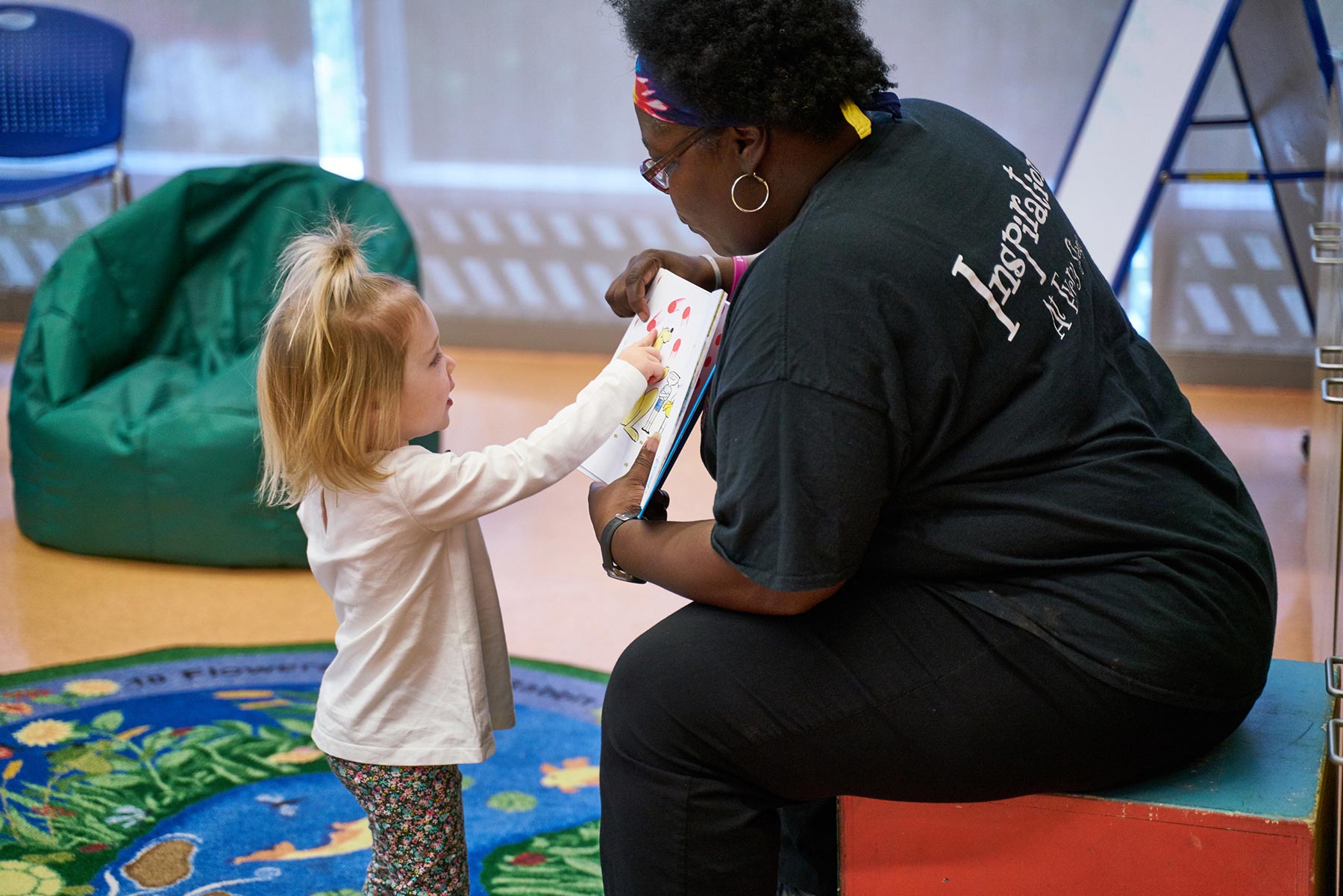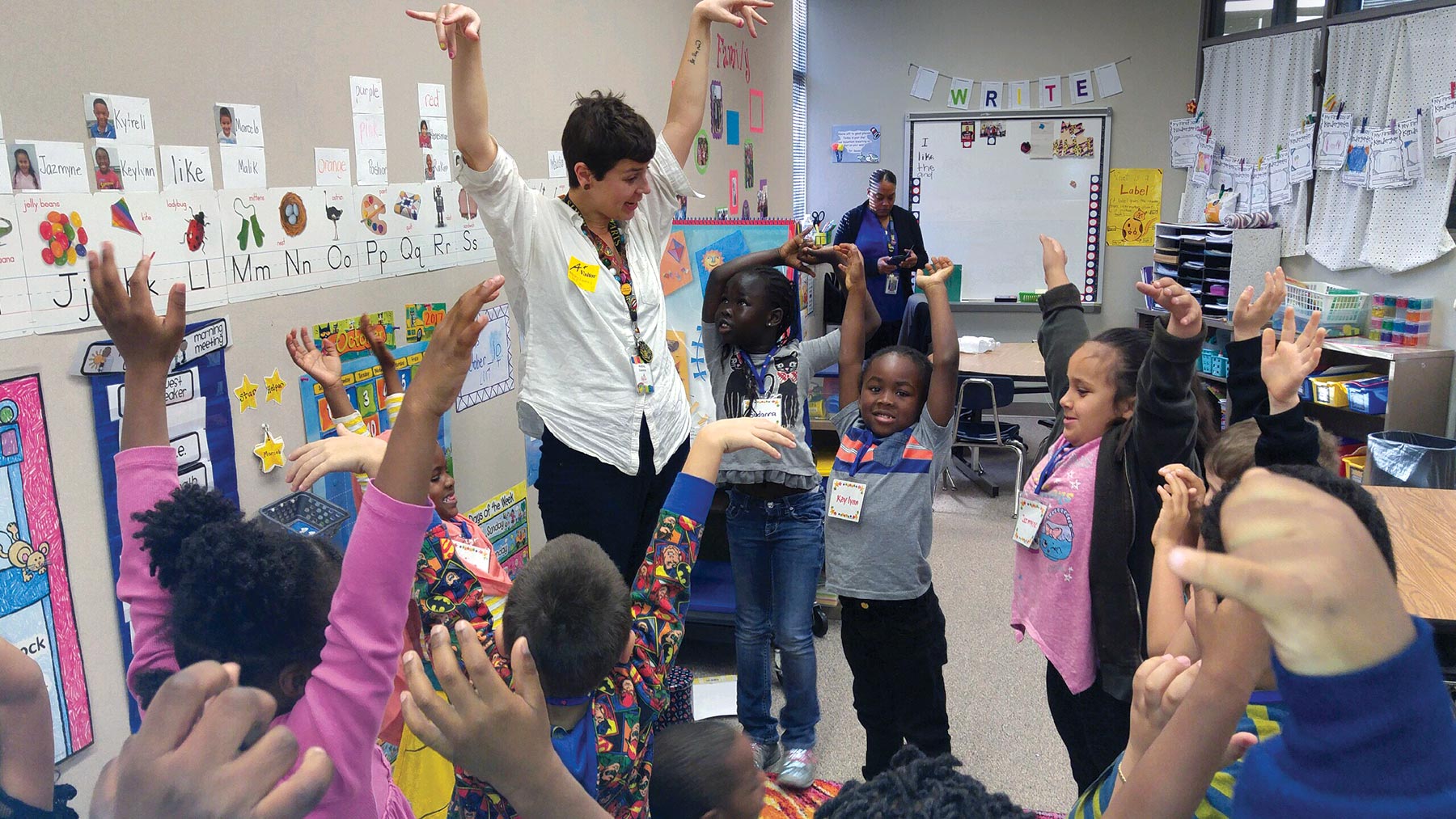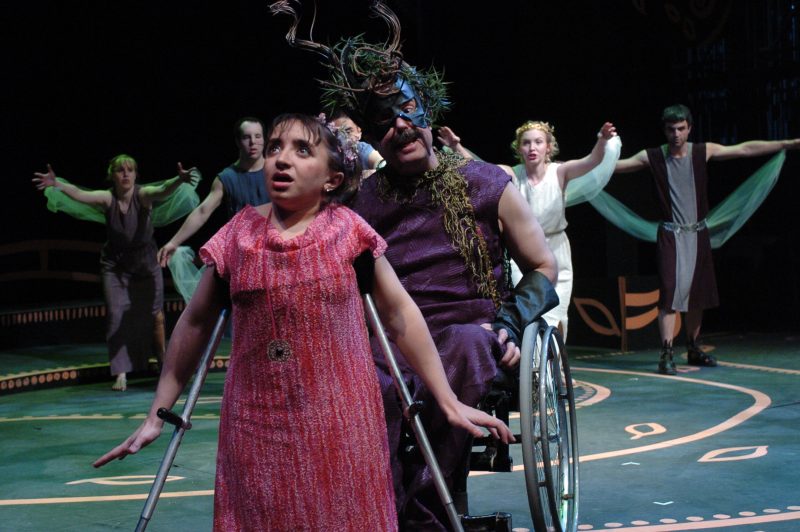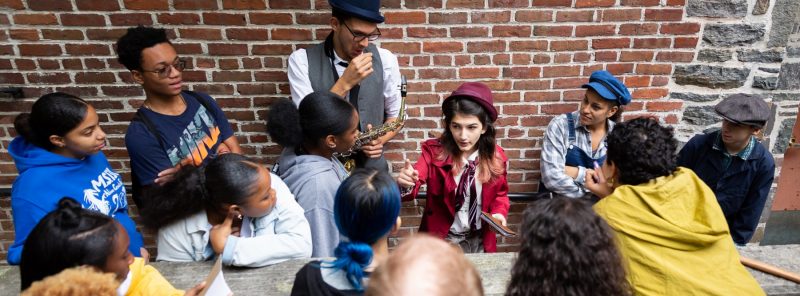Artists-in-residence may work with people in community spaces for a given length of time. The term “residency” is also common in theatre education spaces, with many companies calling work in schools or community settings “residencies;” these program may focus on teaching theatre skills, teaching academic standards through arts integration, or working with participants to create a culminating performance. Some residencies may be taught by artists who teach less frequently but are excited to share their art form. Others are taught by freelance contract teaching artists who may work for numerous companies simultaneously. Some TYA companies have a position allowing both the consistency of a resident acting company and the versatility of a contractor. Sometimes called “resident teaching artist” (RTA) positions, these jobs can look as different as the organizations that house them, but all offer benefits for both the organizations and the individuals in the positions.
Children’s Theatre of Charlotte
Children’s Theatre of Charlotte (CTC) in Charlotte, NC has two full-time RTA positions. In addition to six to seven mainstage shows and several touring productions, CTC provides short- and long-term residency work in schools and other settings, after-school classes, free programming for Title 1 schools to supplement arts education offerings, classes and camps focused on building theatre skills, and the Theatre 360 program, which offers audience engagement activities that accompany mainstage shows. The two resident teaching artists work with a variety of these programs and serve as two primary instructors for the Schools of Theatre Training Program. One RTA, Karen Steele, focuses on creative drama and working with younger students. The other, Mavis Scully, who is in her first year as an RTA, teaches primarily musical theatre, working with older students in skills-based classes. Both RTAs currently serve as facilitators for Dennis Foon’s Liars, a grant-funded production that tours to eighth grade classes and focuses on preventing alcohol and drug abuse. The RTAs facilitate a post-show discussion during which the actors stay in character and converse with the audience. As Michelle Long, CTC director of education, explains, “It was important for us to have the resident teaching artists on tour with the company to facilitate the post-show discussion and to connect with school faculty and staff because of the difficult subject matter of the show, a role that the actors and the stage manager may not be as equipped to handle.” Scully also directs one of the productions in Onstage, a performance festival for students who take part in the School of Theatre Training program.
The Omaha Theater Company for Young People at the Rose Theater
The Omaha Theater Company for Young People at the Rose Theater (the Rose) also employs six full-time teaching artists (plus three teaching artist fellows and three year-long contract positions) who serve multiple functions within the organization. Brian Guehring, education director and playwright-in-residence, explained that these positions grew from an acting company model: the resident artists used to perform in morning matinees, then rehearse the upcoming production in the afternoon. The Rose’s education programming has grown exponentially and now includes creative drama classes, after-school theatre classes, extensive arts integration work in over 75 Omaha elementary schools, accessibility classes, professional development partnerships with teachers, a teen theatre program, and a large preschool partnership including work in Theatre for the Very Young. Throughout this evolution, Guehring has consistently advocated to keep a balance of teaching, performance, and administration for his full-time staff. Ashley Laverty is one of the full-time teaching artists, a company actor, and the director of early childhood at the Rose. She teaches several yearly in-school residencies for students in grades K–5, after-school drama classes, and acting, production-based, and musical theatre classes on Saturdays, as well as summer camps. She also creates and facilitates curriculum for Curriculum Infusion, a drama integration program and an arts-based program for early childhood students; performs in at least one mainstage production per year; and directs one a show as part of the Teens in Performance program.
Metro Theater Company
Metro Theater Company’s (MTC) resident teaching artist supports a broad array of educational and artistic programming. As Education Director Karen Weberman explained, “The goal is to have the RTA involved with as much programming as possible. The person in this role teaches the majority of arts integrated and community building residencies and workshops. The RTA also teaches a large portion of summer camps, as well as participates in our forum theatre program: Say Something Do Something, which focuses on ‘collaborative bullying prevention.’” Additionally, the RTA supports mainstage productions through the creation of educator guides and assists with administrative responsibilities, particularly those related to tracking student participation and demographics for grants and overseeing camp registration. John Wolbers held this position from August 2012 to August 2018, and Gen Zoufal stepped into the role in September of 2018.
“If you’re in the same schools year after year, having that full-time position develops those relationships with the teachers and deepens their relationships with the company.”
— John Wolbers
“A Critical Perspective”: The Role of Resident Teaching Artists in Organizations
In an industry where independent contractors comprise such a large portion of the workforce, sustaining a full-time RTA position is a significant investment for a TYA company. While the Rose’s full-time teaching artists positions have been in place for several decades, many RTA positions are more recent additions, created to fulfill organizational needs as education programming evolves over time. CTC’s resident teaching artist positions are in their fourth season, and MTC’s position is entering its ninth. As Long explained when discussing CTC’s decision to add the RTA positions, “We have a small administrative team and realized that there was enough work to pay one person full-time instead of paying a bunch of people individually and hourly. We wanted someone who could be a resource for other teaching artists and also report in as a staff member on the education programming.” Both Scully and Wolbers noted that they began their employment as independent contractors in teaching artist positions with CTC and MTC respectively, then applied for RTA jobs when they became available.
The multi-faceted nature of RTA work emerged as the way to achieve one of the key benefits organizations mentioned for the RTA position: relationship-building. As Wolbers explained, “If you’re in the same schools year after year, having that full-time position develops those relationships with the teachers and deepens their relationships with the company. If you are teaching a camp, while an independent contractor may teach a wonderful camp and be able to speak to some of the details of what the company is doing as a whole, you [as the RTA] can market a little bit to the campers, saying ‘Hey, we’ve got this great show coming up in the fall,’ and then when they go to the show, and they see their former teacher is helping with front-of-house, they get excited. It helps deepen those relationships with your collaborators and partners but also your audience members and students.” Something similar happens at the Rose, where the full-time teaching artists perform in mainstage productions, which often include class and camp students in their audiences, and sometimes in the performance ensemble. This layered engagement, with students also seeing their teachers as professional artists, yields benefits for students and teaching artists alike. “It’s really exciting for young people to take an acting class with us and see us onstage. It also makes me a stronger teacher and vice versa, a stronger performer for young people. It’s exciting to see my own students in the audience,” Laverty explained. Scully also noted that relationship-building takes place outside the classroom and the rehearsal space through administrative tasks. “The emails that I write back and forth with parents and students are relational, dealing with work in class. I just answered two emails today about kids that are wanting to audition for a performing arts school saying ‘Hey, can you help us choose our monologues because we really trust you?’ I also help parents understand the nature of the business that their children are wanting to be a part of.”

Resident Teaching Artist Karen Steele with young student in Side-By-Side class. Children’s Theatre of Charlotte, Charlotte, NC. Photo by John Merrick.
From an organizational perspective, RTAs also help foster communication between departments. Because organizations that produce work for young audiences frequently offer extensive education programming, the collaboration between the production and education departments is essential. RTAs bring a unique perspective to departmental meetings and strategic planning processes. As Long explained, “The differing perspective is critical. It’s really wonderful to have another full-time person have another set of eyes on the curriculum and delve into the details. We have great meetings, and we come up with really fantastic ideas, but [the RTAs] are the ones that then put them into practice and say, ‘This is working, this is not working, we need to take another look at this.’ They have the relationship to be able to say that, whereas a part-time person teaching one or two nights a week might not feel empowered to say, ‘I’m not sure this is working from a curriculum perspective,’ because this is the curriculum that we’re asking them to teach.” Laverty echoed the importance of her position in connecting the different departments she serves: “Because we are so heavily involved in not just education but also in the production side of things, our education and artistic director collaborate, our production director and education director collaborate, and I think we’re all really invested in the quality of everything.” Guehring explained an additional benefit that these inter-departmental collaborations offer: “We deal with accessibility issues all the time as teachers, so we can be leaders and bring that work to the entire theatre.” He went on to note a key impact of the full-time positions on departmental sustainability: “That’s a tremendous reason we have such low turnover, because it’s collaborative and supportive and a good balance of all these different things. It really helps everybody become the artist they want to be and have the job they want to have and not get burned out and leave.” Four of the Rose’s full-time teaching artists have been with the organization more than 10 years, and two for over 20. Additionally, because the full-time teaching artists allow for artistic, teaching, and administrative collaboration, Guehring noted, “When someone does leave, the institutional knowledge they take with them is tremendous, but because we do so much collaborative work, we’re not starting from scratch on their projects.”
“The fact that I get to do what I love consistently without getting bored, because there are seasons of what happens at this theatre and in our education department, it’s wonderful. The variety, but the consistency – I’ve never had anything like this in my life.”
— Mavis Scully
“The Variety, but the Consistency”: Experiences of Resident Teaching Artists
It is essential to consider the experience of individuals holding these unique positions. Multiple RTAs mentioned similar ideas when describing their experiences and the way their jobs are structured. All three RTAs laughed when asked to describe their day-to-day activities, as though the task was practically impossible. While the positions at each organization hold responsibilities for different elements of the company’s education programming, each RTA engages with a wide variety of programs throughout the season, and sometimes, throughout each day. Zoufal explained, “What’s so fun about the RTA position is that it really can shift so quickly. Some days you’re coming in and teaching all day, and some days you’re really focusing on lesson planning or working on creating materials for different educator guides. That’s why it’s so exciting; it’s always different.” Wolbers, who held Metro’s RTA position until September, when Zoufal stepped into the role, noted, “I really loved the diversity of the day, that in the morning you might be teaching arts integrated science classes with second graders, in the afternoon you might be teaching creative movement with early childhood students, and then right before you go home you might be doing research and lesson planning for community building with middle schoolers, so having no two days look exactly alike.” Guehring explained another positive impact this diversity can have for employees: “One of the huge challenges in our field is how do you avoid burnout. Classroom teachers have longer breaks and they also have summers off. That doesn’t happen in this field. One way that we counter that is the administration time that we do helps lower the number of contact hours we have, either creating the artistic work or the teaching work, so it’s still useful and uses a different kind of energy, so it helps revive a little bit.”
In an industry dominated by contract work, a steady, full-time job with consistent pay and benefits proved a key consideration. The RTA positions also offer opportunities for career growth. For Scully, moving from a twice-a-week class to a full-time position offered a sense of stability after a recent career shift. “I have peace in knowing that I have a full time job. I’m not out there having to hustle. The real gift has been that I can come to a place where there’s job security. There’s a really supportive system of people who love what they’re doing and want to help me do what I’m doing so we can do this for the young people of this area. And the fact that I get to do what I love consistently without getting bored, because there are seasons of what happens at this theatre and in our education department, it’s wonderful. The variety, but the consistency – I’ve never had anything like this in my life.” Laverty also noted what she called a “really amazing benefit” of her full-time position: “As a freelancer, I did not experience watching the growth, in confidence usually, that comes from having the same kids in class year after year. I have a 15-year-old in my middle school class; this is her third year. Now, she volunteers first during improv, when she used to be the quietest.”

Ashley Laverty with kindergarten students in a Curriculum Infusion Program residency. The Rose Theater, Omaha, NE. Photo by Debra Benes.
The same diversity of perspective in the RTA position that proved beneficial for organizations also offers, as Scully described earlier, an opportunity to engage with different programs that draw from across the field. She explained that her position gave her a new perspective on the way theatre companies work: “I’ve had a director’s chair before but I’ve never had my own cubicle, and there’s a whole lot that goes on in that cubicle. On the artistic side, you’re used to saying things like, ‘I’d really like to have a bunch of balloons fly up at the end of the show,’ and then sort of expect that to happen. But now that I sit next to Mr. Finance, I realize what that means to our overall budget. I’m getting quite an education on the fiscal side, which I think is also important for the artistic side.” Artists from other companies echoed the value of understanding how different departments work together, and how their own work across the borders of producing and teaching continues to build bridges between these areas.
Laverty noted that her position’s versatility strengthens her work with young people in the classroom and onstage. She explained, “In a show with eight young people performing, it’s nice to have a teaching artist to model best practice. It’s a big responsibility to need to be on my game in rehearsal. I really need to be showing best practice at all times as an educator and a staff member.” Additionally, she noted her excitement at seeing her students in the audience and knowing that they see her as a practicing artist in addition to being their acting teacher. Particularly for her high school students, their understanding of her work as a professional actor and director helps to promote their investment in class.
The artists also mentioned ways their artistry impacts their teaching and vice versa. Laverty explained how working in various spaces as a teaching artist and the Rose’s director of early childhood informed other areas: “It has made me a stronger practitioner in general. In my first year, I acted in one of the touring pieces for preschool, spent the entire year teaching these same preschool children, then got to write a play for them. I strongly believe that when you are creating work for young people, you should work with young people and understand young people. Certainly it helps me be a better practitioner for young people because I see developmentally where they are and see firsthand what they’re interested in and excited by.” Guehring echoed this sentiment: “As a playwright and artist for young people, we’re trying to be as authentic as we can. I don’t understand how playwrights can write for young audiences if they’re not connected to young audiences. The way I do that is by teaching and working with them all the time.”
“Giving Back to the Field”
Hiring a full-time RTA requires the investment of considerable resources from a TYA organization. The possible benefits for individuals and organizations, however, are significant. The existence of these positions also opens new pathways for individuals within the field of teaching artistry as a whole. As Weberman explained, she sees resident teaching artist positions as “a way of giving back to the field. To have a full-time dedicated position of a teaching artist, who is such an important part of a company, a critical voice at the table, places value on teaching artistry in a way that treats the profession with the respect that it deserves.” As RTAs are advocating for the programs they work within and the students they teach, it seems that their very positions also advocate for the essential, unique work that individuals with expertise in both teaching and artistry, can accomplish for young people and communities.



